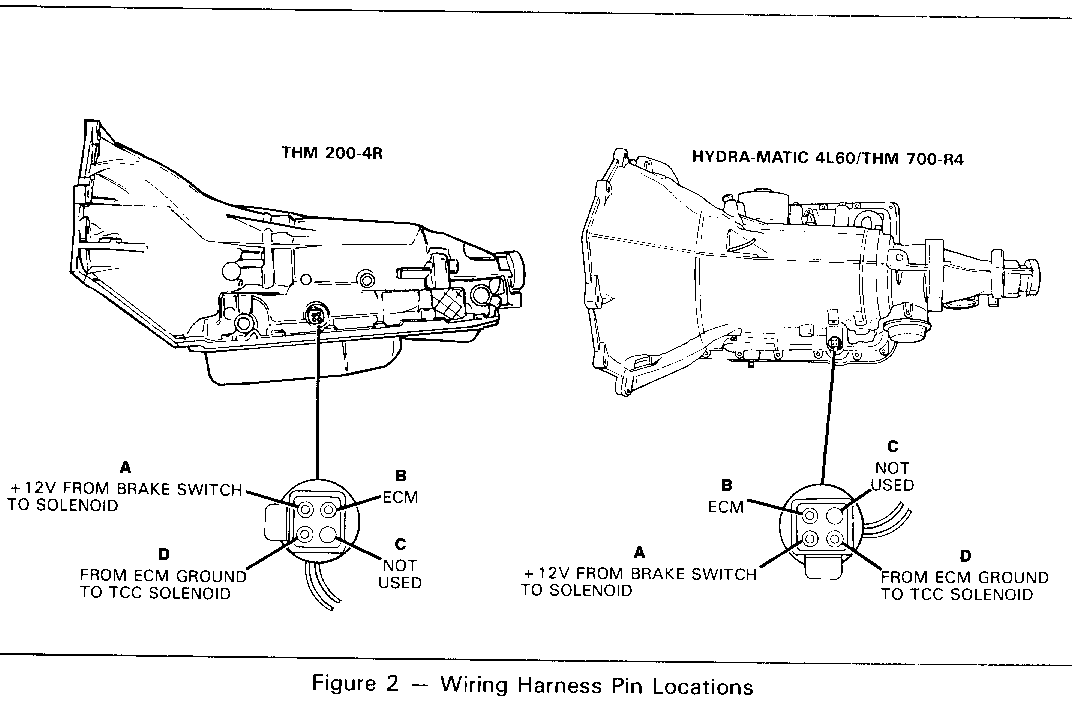POSSIBLE BLOWN VEH. FUSES ON CIRCUITS/SHORTED TCC WIRING

VEHICLES AFFECTED: ALL 1989 VEHICLES WITH 4L60 OR 2004R
BULLETIN COVERS:
Service and parts information for transmission Torque Converter Clutch (TCC) solenoid wiring which may exhibit a breakdown in insulation. This loss of insulation and possible short to ground may cause conditions affecting the vehicle's transmission, electrical system and engine performance. For example, the short may cause blown fuses and/or conditions such as loss of air conditioning, ECM, instrument cluster, etc.
Due to electrical design differences, each vehicle line may display unique conditions. It is also possible to have different conditions exhibited by each division's vehicle within a vehicle line. A short in the TCC circuit will usually blow a fuse on the circuit containing the TCC solenoid. To help determine which fuse may affect an individual model, refer to the "Diagnosis Information" section of this bulletin.
IMPORTANT: Diagnosis information in this bulletin is not contained in any Service Manual.
DATE OF PRODUCTION CHANGE: (Figure 1) -------------------------- Changes to the TCC solenoid wiring entered Production effective May 17, 1989 (Julian Date 137) on all 1989 700-R4/HYDRA-MATIC 4L60 and THM 200-4R transmissions.
SERVICE PROCEDURE: (Figure 2) ------------------ Perform all diagnostic procedures as listed in the applicable Service Manual for a specific electrical condition before checking the transmission. If no cause can be determined, perform the test procedures in this bulletin BEFORE removing the bottom pan of the transmission.
Electrical Testing Vehicle for a Short to Ground
1. Turn off ignition.
2. Disconnect the wiring harness from the transmission at the transmission case.
3. Replace the blown fuse.
4. Start the car and check if vehicle condition is still present.
If the condition is still present, the TCC wiring is probably not the cause. If the condition is not present, test the TCC solenoid wiring.
Testing for a Short to Ground in the TCC Solenoid Wiring
1. Turn off ignition.
2. Disconnect the wiring harness from the transmission at the transmission case.
3. Using a 1.5 volt self powered test light or a high impedance ohmmeter (such as Kent-Moore J 34029-A), insert one probe into terminal A of the harness connector (in the transmission case), and connect the other probe to the transmission case. Observe the test light or ohmmeter. Remove the probe from terminal A and insert it into terminal D. Observe the test light or ohmmeter.
4. If the test light glows or the ohmmeter reads near zero, this indicates a short to ground in either wire A or D of the TCC solenoid wiring.
If a short to ground is detected in either wire, the TCC solenoid wiring must be replaced. DO NOT ATTEMPT TO REPAIR IT!
SERVICE PARTS INFORMATION:
All service stock at CANSPO has been verified good. Refer to the Electrical Diagrams in the Transmission Diagnosis section of the appropriate Service Manual to determine which TCC solenoid wiring assembly is correct for the transmission model you are servicing.
SERVICE MANUAL REFERENCE:
Whenever replacing a TCC solenoid wiring assembly, follow all procedures as outlined in the Transmission Unit Repair section of the applicable Service Manual.
Again, diagnosis information in this bulletin is NOT contained in any Service Manual.
DIAGNOSIS INFORMATION:
The following is a list of vehicle fuses that may be blown if there is a short to ground in the transmission TCC solenoid wiring. This list assumes that each transmission contains three wires in the solenoid wiring assembly. Check the Transmission Diagnosis section of the appropriate Service Manual to determine which wiring assembly is being used.
This is not a complete list of all fuses that may blow. vehicle design differences make it impossible to list every possible circuit configuration that may occur. Consult the electrical diagrams for the vehicle you are servicing to see if additional fuses may be affected.
(circuit 420) (circuit 422) (circuit 446) Vehicle Line If wire A shorts If wire D shorts If wire B shorts ------------ ---------------- ---------------- ----------------- the following fuses may blow:
B car Gauges *See statement TCC enabled (when below available) after a 1-2 upshift D car G.A. Trans
F car Gauges
Y car Gauges
HOLDEN Speedometer
C/K truck ECM/Ign
S/T truck Ign.-Gauges "(N/A 2.5L)
M-Van Gauges
G-Van Gauges
R/V truck Gauges-Idle
If the white wire shorts, three different conditions may occur depending on which wiring assembly is used on a particular transmission:
TCC ENABLED This may occur if the transmission is over temperature and there is a short in the white wire between the TCC and the TCC switch.
TCC ENABLED This may occur if there is a short between the IN SECOND- temperature switch and the ECM. FOURTH
ROUGH ENGINE If the transmission has a fourth gear switch and there is a short between the switch and the ECM, the ECM will always receive a signal that the transmission is in fourth gear. This may affect engine performance if spark timing depends on transmission gear information.


General Motors bulletins are intended for use by professional technicians, not a "do-it-yourselfer". They are written to inform those technicians of conditions that may occur on some vehicles, or to provide information that could assist in the proper service of a vehicle. Properly trained technicians have the equipment, tools, safety instructions and know-how to do a job properly and safely. If a condition is described, do not assume that the bulletin applies to your vehicle, or that your vehicle will have that condition. See a General Motors dealer servicing your brand of General Motors vehicle for information on whether your vehicle may benefit from the information.
